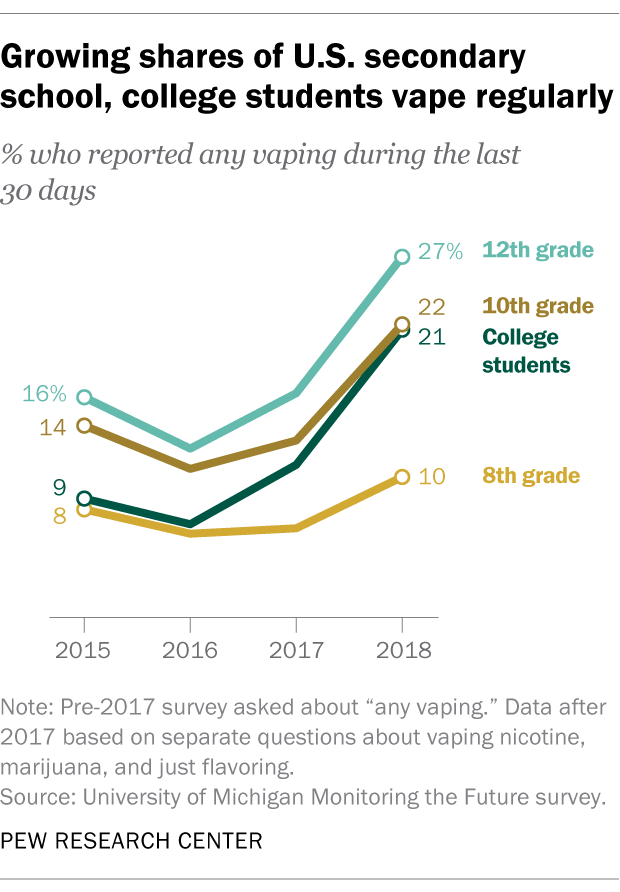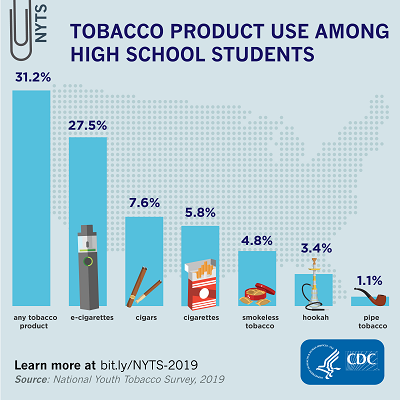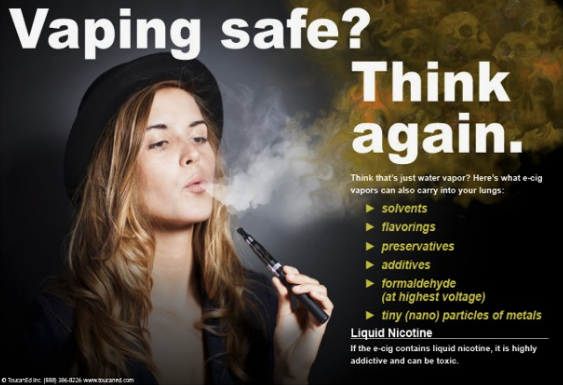Youth & Vaping
E-cigarette Use in Youth Populations
In the U.S., Youth are more likely than adults to use e-cigarettes. In 2018 more than 3.6 million middle and high school students reported using e-cigarettes in the last 30 days.
Current (past 30 day) use of e-cigarettes went up among middle and high school students from 2011 to 2019. [1,2,3,4]
- About 1 of every 10 middle school students (10.5%) reported in 2019 that they used electronic cigarettes in the past 30 days—an increase from 0.6% in 2011.
- More than 1 of every 4 high school students (27.5%) reported in 2019 that they used electronic cigarettes in the past 30 days—an increase from 1.5% in 2011.
As many adults are using e-cigarettes to cut down their use of regular cigareets, only 1.3% of e-cigarette using adults report never bring a regular smoker, compared to the 40% of youth who report never being a regular cigarette smoker before using e-cigarettes.
What makes these products so popular among the youth?
Social and physical environments [5,6]
- The way mass media show tobacco product use as a normal activity can make young people want to try these products.
- Youth are more likely to use tobacco products if they see people their age using these products.
- High school athletes are more likely to use smokeless tobacco than those of the same age who are not athletes. [7, 5]
- Young people may be more likely to use tobacco products if a parent uses these products.
Biological and genetic factors [7,6,5]
- There is evidence that youth may be sensitive to nicotine and that teens can feel dependent on nicotine sooner than adults.
- Genetic factors may make quitting smoking harder for young people.
- A mother’s smoking during pregnancy may increase the likelihood that her children will become regular smokers.
Mental health [5]
- There is a strong relationship between youth smoking and depression, anxiety, and stress. [5]
- Personal views: When young people expect positive things from smoking, such as coping with stress better or losing weight, they are more likely to smoke.2,11
Other influences that affect youth tobacco use include: [5,8,9]
- Lower socioeconomic status, including lower income or education
- Not knowing how to say “no” to tobacco product use
- Lack of support or involvement from parents
- Accessibility, availability, and price of tobacco products
- Doing poorly in school
- Low self-image or self-esteem
- Seeing tobacco product advertising in stores, on television, the Internet, in movies, or in magazines and newspapers

Appeal of Flavors and Marketing for Youth Populations.
https://www.cdc.gov/tobacco/data_statistics/fact_sheets/youth_data/tobacco_use/index.htm
E-cigarettes can come in a variety of fruit, candy, cereal, soda, and other kid-friendly flavors that make these products more appealing compared to regular tobacco cigarettes. A majority of youth e-cigarette users report using flavored varieties, most youth e-cigarette users first start using e-cigarettes with a flavored variety, and flavors are the primary reason youth report using e-cigarettes.
E-cigarettes are also advertised using the same themes and tactics that have been shown to increase youth initiation of other tobacco products, including cigarettes. In 2016, about 8 in 10 middle school and high school students—more than 20 million youth—said they had seen e-cigarette advertising.
Widespread advertising for these products, including via media for which advertising for conventional tobacco products is prohibited (e.g., TV), and the lower costs of some of these products relative to conventional cigarettes has contributed to the increase in e-cigarette use among youth.
Not only are youth reporting initial e-cigarette out of curiosity of these new products and flavors, but because they believe these products to be less harmful compared to conventional tobacco cigarettes.

References
- Gentzke AS, Creamer M, Cullen KA, et al. Vital Signs: Tobacco Product Use Among Middle and High School Students—United States, 2011–2018. Morbidity and Mortality Weekly Report 2019;68:157–164.
- Cullen KA, Gentzke AS, Sawdey MD, et al. e-Cigarette Use Among Youth in the United States, 2019external icon. JAMA. Published online November 05, 2019.
- Wang TW, Gentzke AS, Creamer MR et al. Tobacco Product Use and Associated Factors Among Middle and High School Students—United States, 2019. Morbidity and Mortality Weekly Report, 2019;68(12) [accessed 2019 Dec 6].
- Centers for Disease Control and Prevention. Tobacco Product Use Among Middle and High School Students – United States, 2011 and 2012. Morbidity and Mortality Weekly Report, 2013;62(45):893-7 [accessed 2019 Feb 28].
- U.S. Department of Health and Human Services. Preventing Tobacco Use Among Youth and Young Adults: A Report of the Surgeon General. Atlanta: U.S. Department of Health and Human Services, Centers for Disease Control and Prevention, National Center for Chronic Disease Prevention and Health Promotion, Office on Smoking and Health, 2012 [accessed 2019 Feb 28].
- Centers for Disease Control and Prevention. E-Cigarette Use Among Youth and Young Adults: A Report of the Surgeon General. Atlanta: U.S. Department of Health and Human Services, Centers for Disease Control and Prevention, National Center for Chronic Disease Prevention and Health Promotion, Office on Smoking and Health, 2016 [accessed 2019 Feb 28].
- U.S. Department of Health and Human Services. The Health Consequences of Smoking—50 Years of Progress: A Report of the Surgeon General. Atlanta: U.S. Department of Health and Human Services, Centers for Disease Control and Prevention, National Center for Chronic Disease Prevention and Health Promotion, Office on Smoking and Health, 2014 [accessed 2019 Feb 28].
- U.S. Department of Health and Human Services. Reducing Tobacco Use: A Report of the Surgeon General. Atlanta: U.S. Department of Health and Human Services, Centers for Disease Control and Prevention, National Center for Chronic Disease Prevention and Health Promotion, Office on Smoking and Health, 2000 [accessed 2019 Feb 28].
- Centers for Disease Control and Prevention. E-Cigarette Use Among Youth and Young Adults: A Report of the Surgeon General. Atlanta: U.S. Department of Health and Human Services, Centers for Disease Control and Prevention, National Center for Chronic Disease Prevention and Health Promotion, Office on Smoking and Health, 2016 [accessed 2019 Feb 28].

